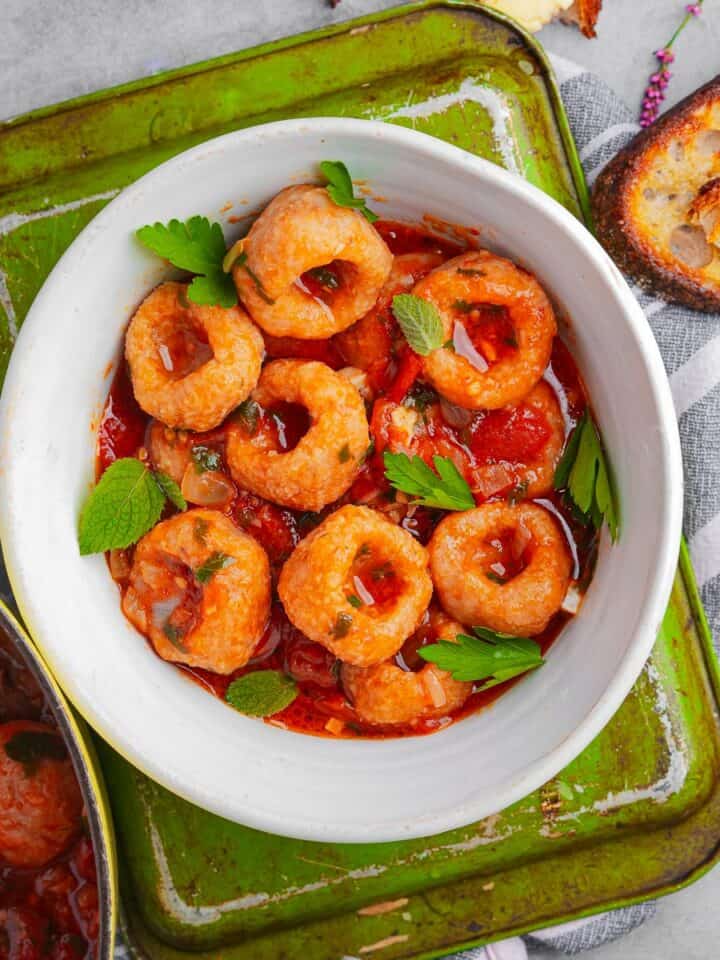Zeytinyağlı Taze Fasulye is a traditional Turkish way to cook runner beans. You can make it with almost any kind of green beans in the pod. This recipe and method work great with French haricots vert, string beans, and even snake beans (aka long beans), like what I use for making sambal goreng.

Zeytinyağlı Taze Fasulye translates to “Fresh Olive Oil Runner Beans” in English. Turkey knows quite a few secrets to unlocking beans and grains. You can see the rustic ingenuity of Turkish cooking on full display in simple summertime dishes like barbunya pilaki, made from seasonal fresh borlotti beans, to Mercimek Köfte (Turkish red lentil meatballs).
What sets Zeytinyagli Taze Fasulye apart is its simplicity, highlighting the natural flavor of each of its ingredients. Fresh runner beans (don't worry you can totally make this with standard string beans too!), lovingly simmered in olive oil, mingle with the sweetness of diced onions and tomatoes, the earthy aroma of minced garlic, and a tiny pinch of sugar to balance it all. Then, there’s that zesty kiss of lemon juice to balance the subtle sweetness, the gentle warmth of ground black pepper, and just the right amount of salt to awaken your senses.
You will nail this exquisite Turkish dish on your very first attempt. I have put together clear instructions, and step-by-step guidance and insider tips, so that you’ll master the art of making Taze Fasulye with ease.
Grab your apron, sharpen your knives, and let’s get cooking!
Jump to:
🥰Why you are going to adore the ever-loving heck outta this recipe
✊ Vegan AF: Like all of my recipes, these runner beans don’t require butter, eggs or animal products of any kind. No cholesterol, reduced impact on the environment, and no harm done to animals make this dish.
🧙♂️ Ingredient Magic: The secret ingredient? Freshness! Using ripe, juicy tomatoes and vibrant runner beans ensures a burst of flavor in every bite. Don’t worry, I will offer some good substitutions.
✅ Tested and Approved Worldwide: Like all of my Turkish recipes, not only have I extensively tweaked this recipe to perfection, it has also been tested and approved by a team of dedicated recipe testers in kitchens all around the globe.
🫘Notable ingredients and substitutions

Runner Beans
Runner beans, often referred to as Fasulye in Turkey, are the heart of this dish. These green pods have a tender, slightly sweet, and earthy flavor. Don’t worry if you can’t get them. This recipe can be made with french string beans, or green beans like you would use in making urap sayur salad, and even snake beans beans like you would use in dishes such as lontong sayur lodeh.
Pul Biber
Pul Biber, or Aleppo pepper flakes, offers mild to moderate heat with fruity, and flavorful undertones. If you don’t have pul biber on hand, crushed red pepper flakes can work as a suitable alternative, but they are a bit hotter and not quite as flavorful, in my opinion. A better substitution option is cobanero chili flakes if you have them.
Lemon Juice
While the cooked onions and tiny bit of sugar in this recipe add some sweetness, the lemon juice balances that to bring out the natural flavor of the beans and tomatoes. Actually, acid and sweetness help boost the taste of the tomatoes a lot. They work together not only to enhance great tomatoes, but to cover up and boost tomatoes that aren’t perfect, if that’s what you have on hand. If you happen to run out of lemons, a dash of white vinegar, rice vinegar, or apple cider vinegar will perform a similar sweetness balancing effect.
Onions
In this recipe, diced onions provide a flavorful foundation for the dish, infusing it with a subtle sweetness as they cook. Shallots (which make a great Indonesian condiment on their own), or thinly sliced leeks can be used as an alternative to onions.
*See the recipe card at the bottom of the page for exact quantities, nutritional info, and detailed cooking directions.
📖 How to cook runner beans perfectly
Nail this dish on your first shot by following these step-by-step instructions with important tips. Or you can follow along with the easy-to-print recipe card towards the bottom of this page.

Step One
Sauté Onions:
Begin by warming the olive oil in a sizable pan over medium heat. After 90 seconds, when the oil is hot, add the diced onions and sauté them for 4-5 minutes until they turn translucent.

Step Two
Add Tomatoes and Garlic:
Stir in the diced tomatoes and minced garlic, and continue sautéing for an extra 4-5 minutes until the fragrance blooms, and the tomatoes start to break down.

Step Three
Combine with Beans and Seasonings:
Stir in your choice of runner beans, string beans, or French green beans to the pan, along with chopped parsley, water, sugar, lemon juice, pepper, and salt.

Step Four
Steam the Beans:
Cover the pan and allow the beans to cook until they reach your preferred level of tenderness. Periodically open the lid to stir and check for doneness. I prefer a shorter cooking time (about three minutes) for beans with some life remaining in them, but feel free to extend it if you prefer them well-cooked.

Step Five
Garnish and Serve:
Transfer the content of the pan into an attractive serving dish and garnish with parsley and, if desired, Aleppo chili flakes. It’s great with some crusty bread like grilled sourdough, flaky parotta or freshly baked kuboos.
💡Serving Ideas
Zeytinyağlı Taze Fasulye adds more green veggie vibes to lots of meals. If you are down with aubergine, Turkish eggplant dishes like Saksuka or Soslu Patlcan Yemegi perfectly complement the earthy goodness of the beans.
Pair your Taze Fasulye with Ezme, a spicy, minced Turkish salad that goes great over plant-based labneh. During the fall and winter, these are great served with root vegetable dishes like Kereviz, or soups like ezogelin or yalya corbasi.
Turkish-style runner beans go great with grains, and some nice Turkish options are bulgur pilavi, tabouleh, cig kofte, and my younger daughter’s favey: rice stuffed cabbage rolls.
Obviously this recipe doesn't just go great with Turkish dishes. Try it as a side on pasta night with spaghetti drenched in vegan bolognese sauce, topped with meatless meatballs and served with vegan garlic bread.
For a more substantial meal, serve Taze Fasulye alongside baharat roasted vegetarian shawarma or Seitan Kofta with tahini and shatta sauce.
Don’t forget a little Irmi̇k Helvası or Pistachio Baklava for dessert!

👉Top tips
- Fresh Beans are Key: Don’t ever make this using frozen string beans. Start with fresh runner beans, as their tenderness and flavor are crucial for the dish. Look for bright, crisp, fresh green beans without any signs of wilting.
- Don’t Overcook the Beans: Keep a close eye on the beans as they cook. A glass lid makes this easy if you have a pan with one. While some prefer them tender, others like them with a bit of crunch. Don’t be afraid to open the lid and check them, because you can always cook them longer if needed, but you don’t want to accidentally cook them beyond your taste.
- Garnish for Freshness: As with most cooked foods, some fresh herbs will bring some life and balance into the final dish. Finish your dish with a garnish of fresh parsley and Aleppo chili flakes, or pul biber.
🤷♀️FAQ
Can I use canned beans or frozen instead of fresh runner beans?
I am not in your house, guarding your freezer door in a rocking chair with a shotgun. But my opinion is that fresh beans will provide the best texture and flavor. I wouldn’t think of making this with lifeless frozen or preserved beans.
How do I adjust the spiciness of the dish?
You can control the spice level by adjusting the amount of Aleppo chili flakes to suit your preference. A teaspoonful of Aci Biber Salcasi can work wonders for a little flavorful fire.
Yes, these Mediterranean green beans can be made and reheated. In fact, they often taste even better the next day as the flavors have had time to mingle.
🥶Storage:
Store any leftover Zeytinyagli Taze Fasulye in an airtight container in the refrigerator. Make sure it’s cooled to room temperature before refrigerating. It can be stored for up to three days.
🔥 Stovetop Reheating:
Place a non-stick skillet or saucepan on the stovetop over low to medium heat.
Add the cold Taze Fasulye Zeytinyagli to the pan.
Stir occasionally to prevent sticking and ensure even heating.
Reheat for about 5-6 minutes or until the dish is warmed through.
🌡️ Microwave Reheating:
Transfer your portion of Taze Fasulye Zeytinyagli to a microwave-safe dish with a lid.
Cover the dish with a microwave-safe lid or microwave-safe plate.
Heat it in the microwave in 30-second intervals, stirring between each interval.
Continue until it reaches your desired temperature, typically 1-2 minutes should suffice.
I would not recommend freezing Zeytinyagli Taze Fasulye, as the beans will become lifeless from cooking, freezing, thawing and reheating. It’s just too much!
✌️My faves to serve with this dish:
Say Hi on Social! 👋
Follow me on Instagram & Facebook for more recipes.
❤️Love this recipe? It helps me out greatly if you leave a 5-star 🌟🌟🌟🌟🌟rating in the recipe card below and maybe even leave me a lovey-dovey comment too!

Zeytinyağlı Taze Fasulye (Turkish-style runner beans)
Ingredients
- ¼ cup olive oil
- 1 cup diced onions
- 1 ¾ cup diced tomato
- 3 cloves minced garlic
- 1 lb. Runner beans (450 g.) or string beans, or French green beans
- 3 tablespoons parsley finely chopped
- ¼ cup water
- ½ teaspoon sugar
- 2 teaspoons lemon juice
- ½ teaspoon ground black pepper
- ¾ teaspoon salt or to taste
To garnish:
- ¼ cup parsley leaves
- 1 teaspoon pul biber or Aleppo pepper flakes
Instructions
- Heat olive oil in a large pan over medium heat. After about 90 seconds, when the oil is hot, add diced onions and sauté for 4-5 minutes until translucent.
- Stir in diced tomatoes and minced garlic and sauté for an additional 6-7 minutes until fragrant, and the tomatoes have started to break down.
- Add runner beans, string beans, or French green beans to the pan, along with parsley, water, sugar, lemon juice, pepper, and salt.
- Cover the pan and let it cook until the beans are just tender, opening the lid periodically to stir and check for doneness. I prefer a shorter cook time of just a few minutes because I like my beans to still have some life left in them. Some people like them cooked more thoroughly, so just add more time if that is you.
- Serve hot, garnished with parsley and Aleppo chili flakes, or pul biber, if desired.










Leave a Reply